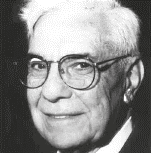Remembering Morton Prince
In late 2022, we learned of the passing of solar pioneer Morton B. Prince. Please find his obituary provided by ISES member, Prof. Larry Kazmerski below.
Morton B. Prince was born in Philadelphia, Pennsylvania on April 1, 1924 and attended the school system in the same city. He received his Bachelor of Arts degree from Temple University in 1947 with a major in physics and a Ph.D. in Physics in 1951 from the Massachusetts Institute of Technology. Upon receiving his Ph.D., he joined the Bell Telephone Laboratories (BTL) in Murray Hill, New Jersey, working under Dr. William Shockley, carrying out studies in the properties of germanium and silicon, and analyzed the physical properties of the new grown p-n junction germanium transistors. In 1953, he started to work on semiconductor devices in Dr. Jack Morton’s device development department where he participated in the analysis and experimental development and improvement of the newly “invented” Bell Solar Battery. He developed a diffusion technique for producing junctions in silicon without destroying the minority carrier lifetime in the material (Patent No. 2, 790, 940). This allowed him to develop an extremely efficient silicon (conductivity modulated) power rectifier using a p-i-n structure for which he received a major publicity release. Other significant devices that he developed include a high frequency silicon diode and a family of diffused silicon Zener diodes. Among his many papers published during his time with the BTL, his paper entitled “Silicon Solar Energy Converters” published in May 1955, in the Journal of Applied Physics, remains the most relevant to photovoltaics.
In 1956, he joined the Hoffman Electronics Corporation, Semiconductor Division, initially as Director of Research and Development, where he helped to commercialize the products he was involved with at the BTL.
This department started with five members and grew to approximately 100 technical personnel (including Martin Wolf, Gene Ralph, Hans Rauchenbach and Bernd Ross) within four years and included work on semiconductor materials and techniques, semiconductor device development and semiconductor device applications. It was in 1957 that his organization showed the Vanguard Satellite engineers the potential for using solar cells for space power. The Vanguard people were convinced and incorporated Hoffman (the only producer at that time) cells in the first space satellite powered by solar cells (it was launched on March 17, 1958).
Hoffman developed a special-sized cell for this application and produced solar cell modules for many satellites and probes after that time. In 1960, Dr. Prince became Division Manager and Corporate Vice-President and was responsible for overall administrative, technical, marketing, manufacturing and financial operations of the Semiconductor Division, encompassing two separate plants, employing more than 1,000 employees. The solar cell efficiency grew from 8% in 1957 to 14% in 1960, by incorporating many new techniques in both material production and device design. Probably, the most important development was the gridded contact on the front of the cell. In 1960, he co-organized the first Photovoltaic Conference in Los Angeles, to bring together researchers and engineers in industry, universities and government laboratories to develop standards for the measurement of solar cells. This preceded the start of the regular IEEE Photovoltaic Specialists Conference.
After leaving Hoffmann, he became involved in other activities including his own organization that developed and produced photon counting equipment. However,
in 1975, when the Energy Research and Development Administration (ERDA-later the Department of Energy) was started, he was invited to join the organization to lead the photovoltaic section and was responsible for planning, funding and monitoring the Federal Photovoltaic Program. The funding of this program grew from $5,000,000 in 1975 to $150,000,000 in 1980 and he stimulated many successful solar cell developments by giving technical and managerial guidance. During the 1980s, with a decreasing interest in solar energy in the U.S. government, the annual budgets dropped dramatically and he held together as much of the program as possible. However, he felt badly about losing many excellent laboratories and individual researchers to the program due to the budgetary limitations. Dr. Prince retired from the program in 1993.
In 1994, Dr. Morton B. Prince was awarded the Becquerel Prize established in 1989 by the European Commission at the occasion of the 150th anniversary of Becquerel’s classical experiment in which he discovered the photovoltaic effect. Its purpose is to honor scientific, technical or managerial merit in the development of photovoltaic solar energy, attained over a long period of continuous achievements, or very exceptionally, for some extraordinary invention or discovery. Prince was recognized for his outstanding contributions with the Bell Telephone Laboratories modern solar cell discovery in 1994, a tipping point for photovoltaics technology. And for a career that helped bring photovoltaic technology as a potential terrestrial world electricity source.
Dr. Prince was the editor of Volume 8 of “Advances in Solar Energy”, published chapters in five books, pub- lished fourteen peer-reviewed papers, presented thirty- five conference papers and gave twenty-eight invited talks. In addition to the Becquerel Prize of the European Commission in 1994, he was awarded the Marconi Premium of the British Institute of Radio Engineers in 1958 for a paper on solar cells. He was honored by the International Solar Energy Society as a pioneer on the occasion of the 50th Anniversary of ISES.
He served on various committees for many organizations, including the Institute of Radio Engineers, American Institute of Aeronautics and Astronautics, WESCON, Institute of Electrical and Electronic Engineers and American Solar Energy Society. He was a member of IEEE (Fellow), American Physical Society and International Solar Energy Society, and the American Solar Energy Society.
